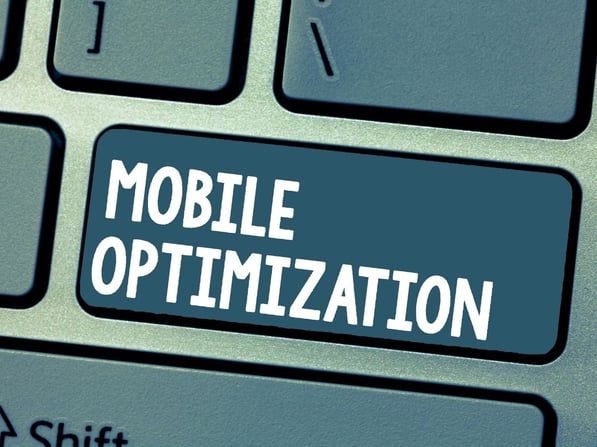10 Tips To Help You Ensure Your Video Game's Mobile Site is Optimized
by Game Marketing Genie, on 01-Apr-2021 10:47:51
Some 6.2 billion people own mobile devices (source: Oberlo)!
Mobile device users heavily dominate web traffic, and your online business will be disadvantaged if you don’t optimize your site for them. So, dive into why mobile site optimization is so important and how to ensure you always meet your goals.
Why mobile optimization?
With people spending more time on their mobile devices, search engines focus heavily on mobile users. Mobile optimization ensures that your website visitors can access your web pages from their mobile devices without any glitches.
Considering screen sizes, page load time, and more, mobile optimization enhances your website’s overall user experience, improves mobile SEO, boosts user engagement, attracts more customers, and makes it easy for visitors to convert.
Search engine giant Google rolled out an algorithm in 2017 to check if sites are mobile-friendly and indexes websites accordingly. This means that your website will only show up at a high ranking on search engine results pages (SERPs) if it is mobile-friendly, or it will be otherwise ignored. So, what must you do to ensure your site is optimized perfectly?

1. Remember that optimizing for phones isn’t enough, you also need to optimize for different phone sizes
You have the freedom to experiment with your site design regarding your desktop version, but there are limitations regarding your mobile version.
With new smartphones in different sizes being released yearly, you must remember that optimizing for just one mobile screen size is not enough. You must improve your mobile site for different phone sizes and orientations. With this in mind, working on your design will help you place clickable content in the right places and enhance your reachability.
2. Simplify your layout, menus and forms
Navigating through clunky websites and menus on mobile can be challenging if they are the same as the regular desktop versions. This is why you must optimize your website and its menu to simplify your users' navigation. The hamburger menu style is one of the most adopted as it facilitates easier navigation and option selection.
Don't forget any forms on your site as well! These can be even more difficult to fill out if they are not optimized compared to their desktop counterparts. Make your forms simple by only asking for necessary information and minimizing the number of fields. This practice will help increase your conversions.
3. Remove pop ups
Pop-ups can capture your audience’s attention on desktop, but when they appear on mobile devices, they disturb the entire user experience. For this reason, Google penalized these on mobile sites that feature intrusive interstitials and pop-up ads.
You don’t want all your efforts to go down the drain by including pop-ups, do you? Alternative approaches like in-text hyperlinks and CTA buttons are a much better way to convert your audience.

4. Use responsive web design
We recommend optimizing your site for different mobile sizes, but how can you achieve that? Responsive web design is the solution. Responsive HTML pages auto-adjust to mobile users’ phone orientation and screen size, making content adjust to suit their device. This will help you enhance your user experience and get your website to rank better on SERPs.
5. Optimize your CTAs
A call to action (CTA) is a button with text, images, or icons that tells website visitors what to do next. Pages with strong CTAs are the ones that have higher conversions, so remember that they should never compete with other page elements. On the contrary, a CTA should be the element that stands out on your web page.
As mobile devices have limited screen space, you need to make your CTAs clear to your audience. Here are a few strategies to make sure yours stand out:
- Create compelling content that highlight your CTAs
- Appeal to your target audience’s emotions (i.e. fear of missing out)
- Use contrasting colors to highlight CTAs
6. Produce different content for mobile
Large blocks of text are complex for mobile users to browse, given that the screen size is small. This is why you must focus on creating different content for your mobile site.
Ensure that you don’t overdo your text content but instead develop concise copy that explains what the web page is about and what your audience can get from taking the desired action.
You’ll also need to ensure that the font size is readable so that users don’t have to adjust their screens to understand what you’re saying. Including infographics, images, and statistics is also a great way to present valuable content to users.

7. Optimize page load speed
Page speed is a metric that shows how fast your content loads on your website. If your page has a lower load time, your users will likely leave your site — resulting in higher bounce rates.
Optimizing your mobile site for higher page load speed is of great importance to convert more customers. Compressing JavaScript, CSS, and HTML files over 150 bytes is one way to increase your page load time.
Additionally, users must wait for extra time for the page transition whenever there's a redirect from your page. By reducing the number of redirects from your page, you can reduce your customer wait time and convert them quicker!
8. Optimize images
Images can take considerable time to load on websites when their file size is too large. Ensuring that your images are of a small file size will mean that your pages load faster and that customers don’t bounce!
Using CSS sprites to create and save image templates for your site will cut down page load time, helping your page retrieve these images faster. Google’s Page Insights recommends compressing your mobile site’s images to 500 KB, which helps cut down page weight by almost 27 percent.
9. Test your website
Testing your website for mobile friendliness is another important mobile marketing strategy that you cannot overlook. Use Google’s test tool to see if your website is mobile friendly, and the areas in which it is lagging.
From showing you how your web page looks on a mobile users screen to highlighting any mobile usability issues, this free tool educates you on the issues that you will have to look into to optimize your site to give mobile users a better user experience.
10. Constantly optimize
You also need to constantly optimize your website to ensure that you stay ahead of the game (and ahead of your competitors).
From allowing search engines to understand your web pages and increasing your clickthrough rates (CTRs) to improving your web pages page ranking, site optimization has many advantages that will benefit you in the long run if you do it consistently.
With new advancements in technology being introduced to the world frequently, by constantly practicing this for your website you can ensure that it looks better, performs up to the industry standards, and stays ahead of the curve.

Optimizing your site to ensure that it is mobile friendly allows you to convert more visitors and make your website responsive. Teaming up with a mobile marketing agency that understands your needs will help you reach your target market better.
Game Marketing Genie is made up of a team of experienced data scientists, marketing managers, campaign strategists and content creators that can help you optimize and maintain your site to ace the SEO game.


